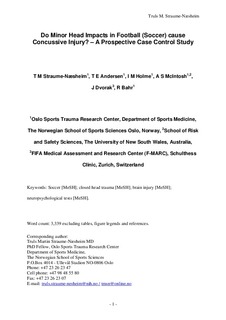| dc.contributor.author | Straume-Næsheim, Truls Martin | |
| dc.contributor.author | Andersen, Thor Einar | |
| dc.contributor.author | Holme, Ingar Morten K. | |
| dc.contributor.author | McIntosh, Andrew | |
| dc.contributor.author | Dvorak, Jiri | |
| dc.contributor.author | Bahr, Roald | |
| dc.date.accessioned | 2010-04-13T10:14:22Z | |
| dc.date.issued | 2009-04 | |
| dc.identifier | Seksjon for idrettsmedisinske fag / Department of Sports Medicine | |
| dc.identifier.citation | Neurosurgery. 2009, 64(4), 719-725 | en |
| dc.identifier.issn | 0148-396X | |
| dc.identifier.uri | http://hdl.handle.net/11250/170529 | |
| dc.description | I Brage finner du siste tekst-versjon av artikkelen, og den kan inneholde ubetydelige forskjeller fra forlagets pdf-versjon. Forlagets pdf-versjon finner du på www.lww.com: http://dx.doi.org/10.1227/01.NEU.0000340681.12949.6D / In Brage you'll find the final text version of the article, and it may contain insignificant differences from the journal's pdf version. The definitive version is available at www.lww.com: http://dx.doi.org/10.1227/01.NEU.0000340681.12949.6D | en |
| dc.description.abstract | OBJECTIVE: Our objective was to determine whether minor head trauma in elite soccer
matches causes measurable impairment in brain function.
METHODS: Baseline neuropsychological testing was completed by professional soccer
players in the Norwegian elite league, Tippeligaen, before the 2004 and 2005 seasons
(n 462). A player who experienced a head impact during a league match completed
a follow- up test the next day (head impact group). Videotapes of all impacts were
collected and reviewed. A group of players without head impacts was also tested after
a league match to serve as controls (matched control group; n 47).
RESULTS: A total of 228 impacts were identified, and 44 (19.3%) of these were followed
up with a CogSport test (CogState, Ltd., Charlton South, Australia; the players
who were tested tended to have more severe injuries, but there were only 6 cases with
loss of consciousness). The head impact group had a greater change in reaction time from
baseline to follow- up compared with the matched control group with regard to the 3
simplest tasks. The largest deficits were seen among the players reporting acute symptoms
after the impact, but deficits were also demonstrated among asymptomatic players.
Players who experienced 1 or more head impacts during the 2004 season showed
a reduction in neuropsychological performance when tested before the 2005 season.
However, none of these players was impaired when compared with the test manufacturer’s
normative data.
CONCLUSION: A reduced neuropsychological performance was found after minor
head impacts in soccer, even in allegedly asymptomatic players. However, the longterm
cognitive consequences are uncertain. | en |
| dc.format.extent | 83617 bytes | |
| dc.format.mimetype | application/pdf | |
| dc.language.iso | eng | en |
| dc.publisher | LWW | en |
| dc.subject | brain injury | en |
| dc.subject | closed head trauma | en |
| dc.subject | neuropsychological tests | en |
| dc.title | Do minor head impacts in soccer cause concussive injury? : a prospective case-control study | en |
| dc.type | Peer reviewed | en |
| dc.type | Journal article | en |
| dc.subject.nsi | VDP::Medical disciplines: 700 | en |
| dc.source.pagenumber | 719-725 | en |
| dc.source.volume | 64 | en |
| dc.source.journal | Neurosurgery | en |
| dc.source.issue | 4 | en |
